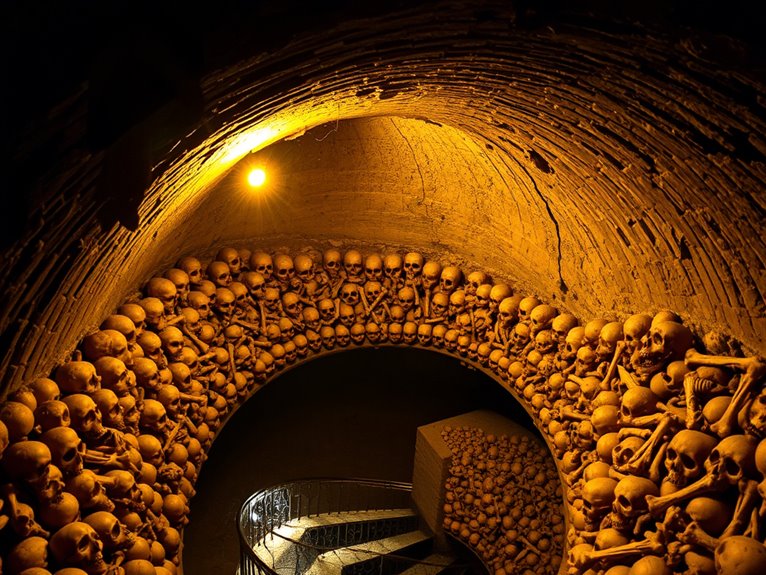
7 Unique Underground Sites in Paris Open to Visitors
I've discovered seven fascinating underground sites in Paris that'll amaze you! You can explore the ancient crypts of Saint-Sulpice Church, venture through Les Carrières limestone quarries, visit the WWII German Command Bunker, peek into the abandoned Arsenal Metro station, wander the medieval Louvre cellars, trace the hidden River Bièvre, and investigate Château de Vincennes' secret tunnels. Each site offers guided tours with unique historical perspectives and architectural wonders waiting to be uncovered!
The Underground Crypts of Saint-Sulpice Church
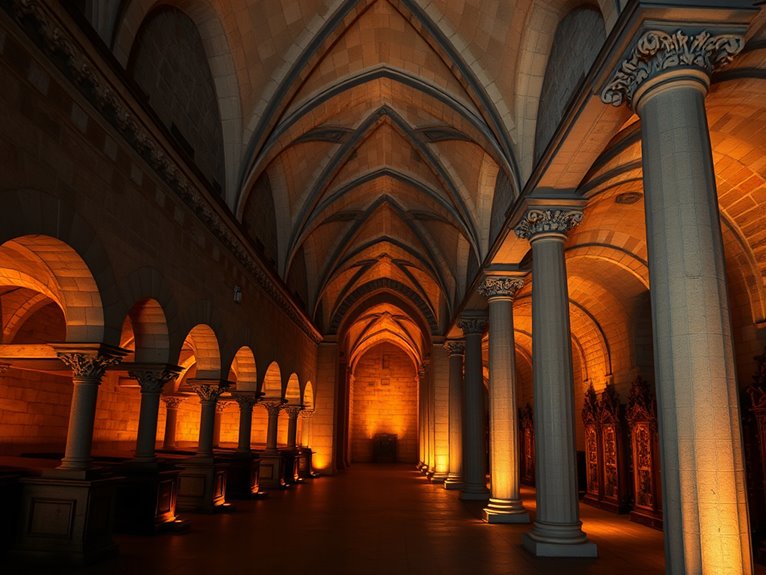
Beneath the magnificent Saint-Sulpice Church, the second-largest church in Paris, lies a mysterious network of crypts that tells tales spanning several centuries of Parisian history. These lesser-known underground chambers, dating back to the 13th century, offer visitors a unique glimpse into the burial practices, architectural evolution, and religious traditions of medieval Paris.
While millions flock to the more famous catacombs, the Saint-Sulpice crypts remain relatively undiscovered, making them an ideal destination for history enthusiasts and curious travelers seeking authentic underground Paris experiences. The crypts feature remarkable stone archways, ancient burial chambers, and religious artifacts that have survived numerous historical periods, including the French Revolution.
Quick Facts:
- Visiting Hours: Tuesday-Saturday, 10:00 AM – 4:00 PM
- Admission: €8 for adults, €5 for students
- Guide Required: Yes (included in ticket price)
- Photography: Limited, no flash
- Tour Duration: 45-60 minutes
- Physical Requirements: Ability to walk stairs and narrow passages
- Language Options: French and English tours available
- Maximum Group Size: 15 people
The Main Crypt Chamber
The central chamber, the largest of the underground spaces, features impressive Gothic vaulting and houses several notable tombs of church dignitaries and noble families. The chamber's acoustics are particularly remarkable, demonstrating medieval architectural expertise. Located directly beneath the church's nave, this space maintains a constant temperature of 15°C year-round. Insider tip: Look for the barely visible medieval mason marks on the stone pillars, which served as signatures of the original craftsmen.
The Ancient Burial Gallery
This narrow corridor contains some of the oldest burials in the complex, dating from the 13th to 16th centuries. The walls feature carved niches and worn inscriptions that provide fascinating insights into medieval burial practices. The gallery extends approximately 30 meters and connects to a small chapel used for private prayers. Insider tip: The third alcove on the right contains a perfectly preserved 14th-century funeral inscription, easily missed without careful observation.
The Revolutionary Hide
A small chamber near the eastern end of the crypts served as a hiding place for clergy during the French Revolution. This space contains several secret passages, including one that allegedly connected to nearby buildings. While most of these passages are now sealed, their entrances remain visible. Insider tip: Look for the subtle arrow carved into the floor near the chamber's entrance, pointing toward the escape route.
Pro Tips:
The best time to visit is during weekday mornings when fewer tourists are present, allowing for a more intimate experience. Consider booking the first tour of the day when the air is freshest and the lighting creates the most dramatic shadows. For photography enthusiasts, bring a camera with good low-light capabilities and a steady hand, as tripods are not permitted in the narrow spaces.
Practical Advice:
Wear comfortable, flat shoes with good grip, as the stone floors can be uneven and sometimes damp. The temperature remains cool year-round, so bringing a light jacket is recommended even in summer. Visitors with claustrophobia should be aware that some passages are narrow and ceiling heights vary. Advance booking is essential during peak tourist season (June-August) and can be done through the church's official website or local tourism office.
Les Carrières De Paris: Ancient Limestone Quarries
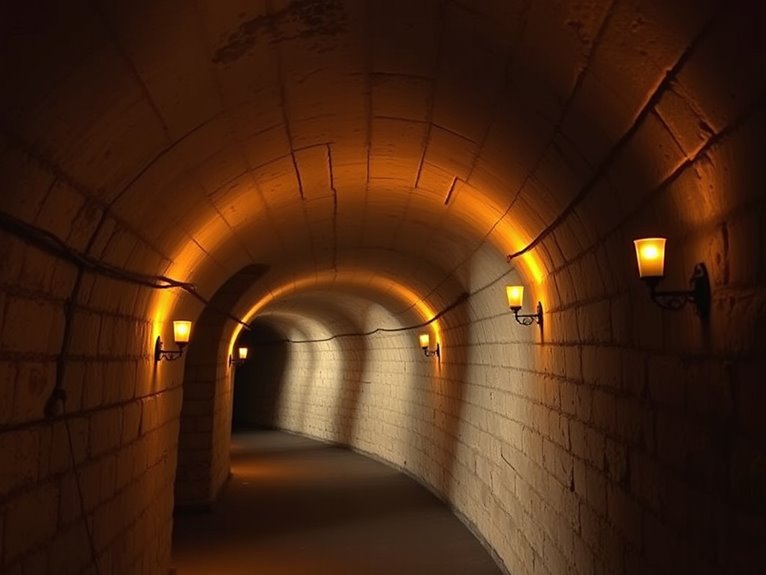
Beneath the bustling streets of Paris lies an intricate network of ancient limestone quarries that have shaped both the physical and cultural landscape of the city. These historic quarries, dating back to Roman times, provided the iconic cream-colored stone used to construct numerous Parisian landmarks, including Notre-Dame Cathedral and the Louvre. Today, these underground passages span over 300 kilometers, creating a mysterious subterranean world that tells the story of Paris's architectural evolution.
While portions of these quarries have been transformed into the famous Catacombs, vast sections remain relatively unknown to tourists, offering a unique glimpse into Paris's geological and architectural history. These underground chambers and tunnels, some reaching depths of 20 meters, showcase ancient mining techniques, geological formations, and centuries of human interaction with the underground landscape.
Quick Facts:
- Access: Limited to guided tours or special permissions
- Temperature: Constant 14°C (57°F) year-round
- Photography: Limited, flash photography prohibited
- Physical Requirements: Ability to walk on uneven surfaces and climb stairs
- Duration: Tours typically last 2-3 hours
- Equipment Needed: Sturdy shoes, warm clothing
- Best Time to Visit: Year-round (temperature remains constant)
- Cost: €15-30 for authorized tours
Official Access Points:
The Inspection Générale des Carrières (IGC) organizes periodic visits to restricted sections of the quarries. These tours provide historical context, geological information, and access to areas typically closed to the public. Advance booking is necessary, as spots fill quickly. Location: Various entry points throughout Paris, primarily in the 5th, 6th, 13th, and 14th arrondissements.
Historical Significance:
The quarries played a significant role in Paris's development from the 1st century CE through the 19th century. Mining ceased in 1813, but the network remains essential for understanding the city's underground infrastructure. Unique architectural features include support pillars, carved dates, and ancient mason marks that document centuries of extraction work.
Alternative Tours:
While unofficial "cataphile" tours exist, it's strongly recommended to stick with authorized visits through the IGC or approved tour operators. These guarantee safety and legal compliance while providing expert commentary on the quarries' historical and geological significance.
Pro Tips:
Timing is important when planning a quarry visit. Book IGC tours several months in advance, especially during peak tourist seasons. Consider visiting during off-peak hours (typically early morning) for smaller group sizes and more personalized attention from guides. Bring a light jacket regardless of surface weather, as the temperature remains consistently cool underground.
Practical Advice:
Safety is paramount when exploring the quarries. Never attempt unauthorized access, as it's both dangerous and illegal. Wear appropriate footwear with good grip, as surfaces can be slippery. Bring a small flashlight as backup, even on guided tours, and be prepared for narrow passages and occasional low ceilings. Those with claustrophobia should carefully consider whether this experience is suitable for them.
The Bunker of German High Command
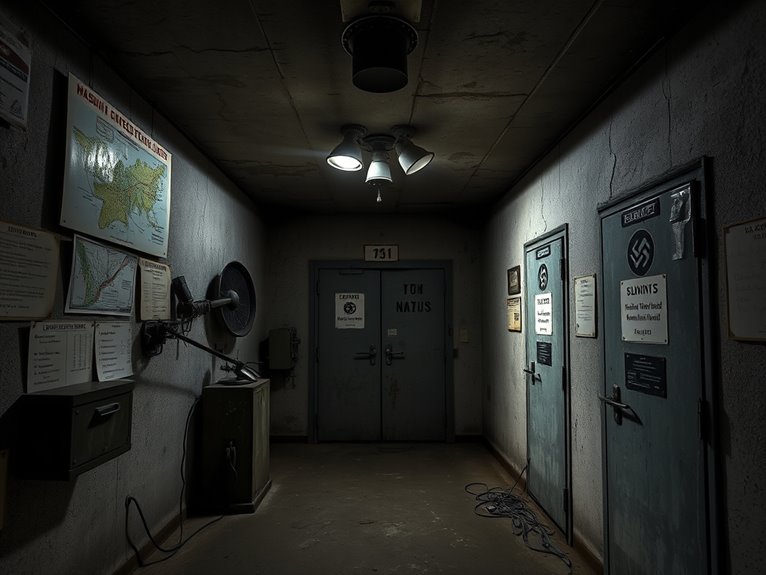
The Bunker of German High Command in Paris stands as a sobering reminder of the city's World War II history, hidden beneath the bustling streets of the 16th arrondissement. This concrete fortress, built in 1943, served as the nerve center for Nazi military operations in occupied France, with its maze of underground corridors and command rooms remaining remarkably preserved.
Today, this historical site offers visitors a rare glimpse into the strategic military installations of WWII, featuring original maps, communication equipment, and living quarters that tell the story of Paris under occupation. While less known than the city's famous catacombs, this bunker provides an equally compelling journey into Paris's subterranean past, offering both historical significance and architectural intrigue.
Quick Facts:
- Opening Hours: Tuesday-Sunday, 10:00-17:00 (closed Mondays)
- Admission: €12 adults, €8 students/seniors
- Guided Tours Only: Available in French and English
- Photography: Permitted without flash
- Location: 20 Boulevard Delessert, 75016 Paris
- Duration: Tours last approximately 90 minutes
- Accessibility: Not suitable for wheelchair users
- Temperature: Consistently cool (14°C/57°F)
Main Bunker Features:
The Command Center remains the bunker's most impressive space, featuring original military maps and strategic planning tables. The room's 3-meter-thick concrete walls and advanced ventilation system demonstrate the technological capabilities of wartime engineering. Visitors can see the actual chairs where German officers planned their operations, with detailed explanations of the communication systems used.
Living Quarters:
The preserved living spaces provide insight into daily life within the bunker. Personal effects, furniture, and military equipment remain in place, offering an authentic perspective on wartime conditions. The kitchen and sleeping areas are particularly well-preserved, with original fixtures and fittings intact.
Communication Room:
The telecommunications center houses original radio equipment and encryption devices. This room played a significant role in coordinating military movements across occupied France. An often-overlooked detail is the backup power system, still visible in its original location.
Pro Tips:
Book the first morning tour to avoid larger groups and enjoy a more intimate experience. The lighting conditions are best for photography during early tours, and guides typically have more time for questions. Consider combining your visit with the nearby Trocadéro Gardens for a full morning of historical exploration.
Practical Advice:
Wear comfortable, flat shoes as the floors can be uneven, and bring a light jacket as the bunker maintains a cool temperature year-round. Advance booking is essential, especially during peak tourist season (June-August). The site offers limited English-language tours, so book these well in advance. Photography enthusiasts should bring cameras with good low-light capabilities, as artificial lighting is minimal to preserve the authentic atmosphere.
Arsenal Metro Station: A Ghost Station Frozen in Time
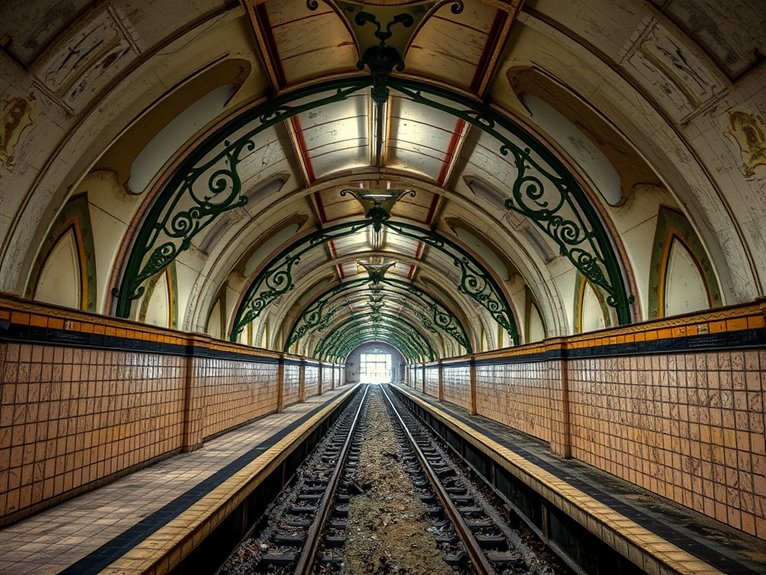
Abandoned Metro Stations: Arsenal's Hidden History
———————————–
Deep beneath the bustling streets of Paris lies Arsenal, one of the city's most intriguing ghost stations, frozen in time since its closure in 1939. Located between Bastille and Quai de la Rapée on Line 5, this atmospheric underground space offers a fascinating glimpse into Paris's early 20th-century transportation history, complete with original art nouveau tilework and vintage advertising posters.
While Arsenal remains closed to regular public access, it represents a compelling piece of Parisian underground heritage and occasionally opens for special guided tours organized by the RATP (Paris's transit authority). The station's preserved state makes it a unique time capsule, offering visitors a rare opportunity to experience the authentic ambiance of Paris's early metro system.
Quick Facts:
- Access: Special RATP guided tours only (typically 2-3 times per year)
- Tour Duration: 1.5 hours
- Cost: €25-40 per person
- Photography: Limited, no flash photography allowed
- Physical Requirements: Must be able to climb stairs
- Group Size: Maximum 15 people per tour
- Language: French tours with English translation available
- Booking: Must be done months in advance through RATP's cultural program
Station Features and History
The Arsenal station opened in 1906 as part of Paris's expanding metro network. Named after the nearby Arsenal district, the station features distinctive cream and brown tiling patterns characteristic of early metro design. The platform spans 75 meters, with original signage and period-appropriate advertising still visible on the walls. The station closed due to its proximity to Bastille station and low passenger numbers.
Special Access Opportunities
RATP occasionally organizes cultural heritage tours that include Arsenal among other abandoned stations. These tours provide historical context, technical information about the metro system, and access to normally restricted areas. Participants must sign liability waivers and follow strict safety protocols due to the station's location within an active metro network.
Pro Tips
For the best chance of securing a spot on these exclusive tours, register for RATP's cultural newsletter and monitor their website during Heritage Days (Journées du Patrimoine) in September. Photography enthusiasts should bring fast lenses suitable for low-light conditions, as artificial lighting is minimal. Consider combining your visit with exploration of the nearby Bastille area's historical sites to maximize your understanding of the district's evolution.
Practical Considerations
Given the limited access opportunities, planning well ahead is essential. Tours require advance registration and fill up quickly when announced. Wear comfortable, closed-toe shoes and bring a light jacket, as the station maintains a constant cool temperature year-round. While waiting for tour opportunities, consider visiting the nearby Musée Carnavalet, which houses exhibits on Parisian transportation history, including artifacts from abandoned metro stations.
The Medieval Cellars of the Louvre
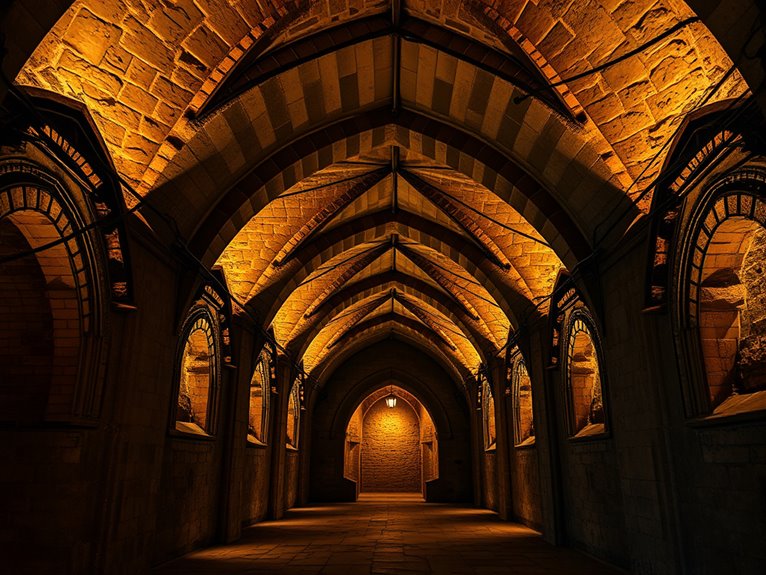
Beneath the world's most famous museum lies a fascinating network of medieval cellars that tell the story of the Louvre's transformation from a 12th-century fortress to a royal palace. These underground chambers, largely unknown to most visitors, represent some of the oldest surviving structures of the original Louvre fortress built by Philip II.
These atmospheric stone vaults, accessible through guided tours, offer visitors a unique glimpse into medieval Paris and the foundations upon which the modern museum stands. The cellars feature remarkable Gothic architecture, including ribbed vaults and massive stone pillars, while archaeological remains help illustrate the daily life of the medieval castle's inhabitants.
Quick Facts:
- Visiting Hours: Tuesday-Sunday, 9:00-17:30 (as part of guided tours only)
- Tour Duration: 90 minutes
- Cost: €15 (additional to regular museum admission)
- Photography: Allowed without flash
- Accessibility: Not suitable for wheelchair users
- Language: Tours available in French and English
- Group Size: Maximum 15 people
- Advance Booking: Required, at least 48 hours ahead
Medieval Kitchen Area
The former kitchen area reveals sophisticated medieval cooking methods through its preserved fireplaces and storage spaces. Notable features include smoke vents and water drainage systems that were remarkably advanced for their time. Located in the northwestern section, this area provides fascinating insights into medieval culinary practices and castle life. Insider tip: Look for the merchant marks carved into the stone walls, indicating where different suppliers stored their goods.
The Philippe Auguste Tower Foundation
This massive foundation of the original defensive tower offers a rare opportunity to see 12th-century military architecture up close. The 4-meter-thick walls demonstrate the impressive engineering capabilities of medieval builders. The foundation sits at the southeastern corner of the medieval fortress. Insider tip: Touch the original limestone blocks – you can still see medieval stonemason marks that helped track their work.
The Defensive Moat Remains
Preserved sections of the original moat provide evidence of the Louvre's military origins. Archaeological findings here include medieval weapons and everyday objects that paint a vivid picture of life in medieval Paris. Insider tip: Look for the water level marks on the walls, showing how the Seine's water levels have changed over centuries.
Pro Tips:
The cellars maintain a constant cool temperature year-round, so bringing a light jacket is advisable even in summer. To get the most atmospheric experience, book the first morning tour when the lighting creates dramatic shadows among the ancient stonework. The most impressive photos can be captured in the kitchen area, where natural light filters through original medieval ventilation shafts.
Practical Advice:
Book tours well in advance, especially during peak tourist season (June-August). Wear comfortable, non-slip shoes as the medieval stone floors can be uneven and sometimes slightly damp. Bring a small flashlight to better examine architectural details, though guides provide basic lighting. Those with claustrophobia or mobility issues should note that some passages are narrow and require maneuvering steep medieval stairs.
Underground River Bièvre: Paris's Hidden Waterway
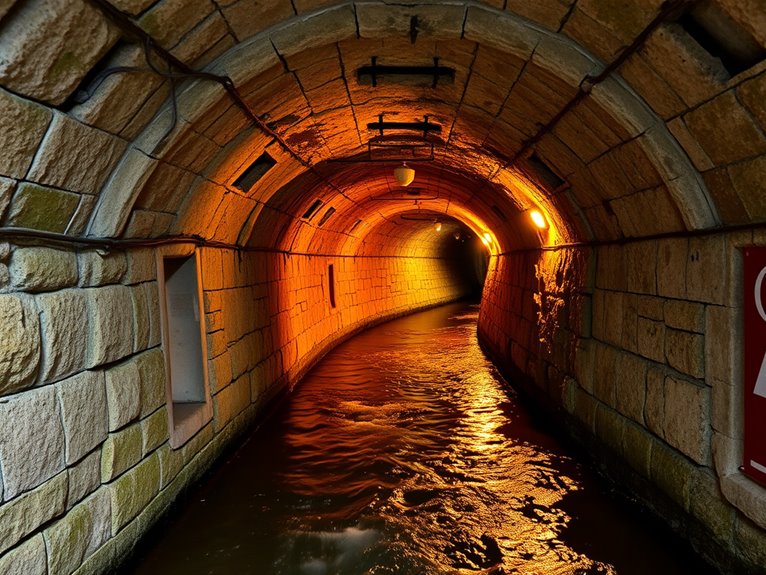
Beneath the bustling streets of Paris lies a mysterious underground river that once played a crucial role in the city's development. The River Bièvre, now largely hidden from view, flows beneath the 5th and 13th arrondissements, carrying centuries of Parisian history in its subterranean course. This ancient waterway, which joined the Seine near the Austerlitz station, was gradually covered during the 19th and early 20th centuries as Paris modernized.
Once a life-giving artery for medieval Paris's tanners, dyers, and millers, the Bièvre's underground journey offers a fascinating glimpse into the city's industrial past and urban evolution. While most of the river remains concealed, several access points and restored sections provide unique opportunities for visitors to connect with this hidden aspect of Parisian heritage, making it an intriguing destination for those seeking to explore beyond the typical tourist attractions.
Quick Facts:
- Best viewing times: Guided tours available March-October
- Access: Only through authorized guided tours
- Cost: €15-25 per person for guided tours
- Duration: Tours typically last 2-3 hours
- Physical requirements: Must be able to walk on uneven surfaces and climb stairs
- Photography: Limited opportunities, flash photography not permitted
- Language: Tours available in French and English
Visible Sections at Parc Kellermann:
A rare glimpse of the Bièvre can be seen at Parc Kellermann in the 13th arrondissement, where a small section has been restored to daylight. This peaceful garden setting showcases how the river once appeared throughout Paris, with informative plaques detailing its historical significance. The park is open daily from 8:00 AM to sunset, and entrance is free.
Insider tip: Visit during spring when the restored riverbanks bloom with native plants that once grew wild along the Bièvre.
Underground Tour Access Points:
The most thorough way to experience the Bièvre is through guided tours starting at Place Valhubert. These tours, operated by Paris's water authority, take visitors through specially maintained tunnels that follow the river's original course. Advance booking is essential, with tours limited to 12 participants.
Insider tip: Request the extended tour option, which includes access to a preserved 19th-century tannery basement normally closed to the public.
Pro Tips:
The best time to explore the underground sections is during the cooler months of spring and fall when the tunnels maintain a comfortable temperature. Book tours at least three months in advance, especially for English-language options, as they fill quickly. Wear sturdy, waterproof shoes and bring a light jacket, as the underground passages remain cool year-round. Photography enthusiasts should bring fast lenses suitable for low-light conditions, as artificial lighting is minimal to preserve the authentic atmosphere.
Practical Advice:
For the safest and most enriching experience, only visit the underground sections with authorized guides. While some unofficial access points exist, they are dangerous and illegal to enter. Visitors with claustrophobia or mobility issues should stick to the above-ground sections at Parc Kellermann or consider the virtual tour options available at the Paris Sewers Museum, which includes detailed exhibitions about the Bièvre's history and its role in shaping modern Paris.
The Secret Tunnels of Château De Vincennes
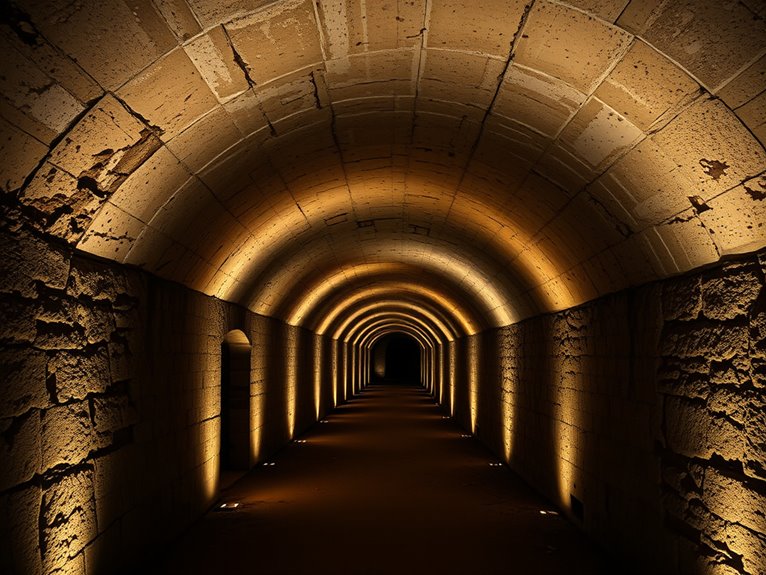
Beneath the majestic Château de Vincennes lies a labyrinth of mysterious tunnels, offering visitors a glimpse into the fortress's strategic military past. These underground passages, constructed between the 14th and 17th centuries, served as essential communication routes, escape paths, and storage facilities during times of siege and conflict.
The network of tunnels spans several kilometers, connecting various parts of the château complex, including the keep, chapel, and outer fortifications. While only a portion is accessible to the public today, these underground galleries provide fascinating insights into medieval military architecture and the ingenious defensive systems employed by French royalty.
Quick Facts:
- Opening Hours: Tuesday-Sunday, 10:00-17:00 (October-March), 10:00-18:00 (April-September)
- Admission: €9.50 for adults (includes castle access)
- Guided Tours Only: Mandatory for tunnel access
- Duration: 45-60 minutes
- Temperature: 12-15°C year-round
- Photography: Permitted without flash
- Physical Requirements: Must be able to walk stairs and narrow passages
The Medieval Keep Tunnels
The most extensive section of tunnels connects to the medieval keep, featuring original 14th-century stonework and architectural elements. These passages showcase medieval engineering expertise with their precise vault construction and drainage systems. Located beneath the main keep, tours begin every hour and require advance booking during peak season.
Insider Tip: The acoustics in certain tunnel sections create unique sound effects – ask your guide about the "whisper galleries."
The Royal Chapel Connection
A lesser-known tunnel system links the château's Saint-Chapelle to the royal apartments. These passages feature remnants of original wall paintings and carved stone details from the 15th century. Access is limited to small groups of 12 people maximum.
Insider Tip: Look for the mason's marks carved into the tunnel walls – these signature symbols helped identify which craftsmen worked on specific sections.
The Defensive Network
The outer defensive tunnels, built during the 17th century, formed part of the château's military infrastructure. These passages include ammunition storage rooms and observation posts. Some sections still display original wooden support beams and iron fittings.
Insider Tip: The northwestern tunnel section contains rare examples of military engineering drawings carved directly into the walls.
Pro Tips:
For the best experience, visit during weekday mornings when groups are smaller and guides can provide more detailed explanations. The tunnels maintain a constant temperature year-round, making them an excellent refuge during summer heat or winter cold. Photography enthusiasts should bring fast lenses (f/1.8 or faster) as lighting is minimal in many sections.
Practical Advice:
Wear comfortable, non-slip shoes and bring a light jacket regardless of the season. While the main tunnels are well-maintained and lit, some sections have uneven floors and low ceilings. Visitors with claustrophobia or mobility issues should inquire about alternative tour options that focus on the more spacious sections of the underground network.
